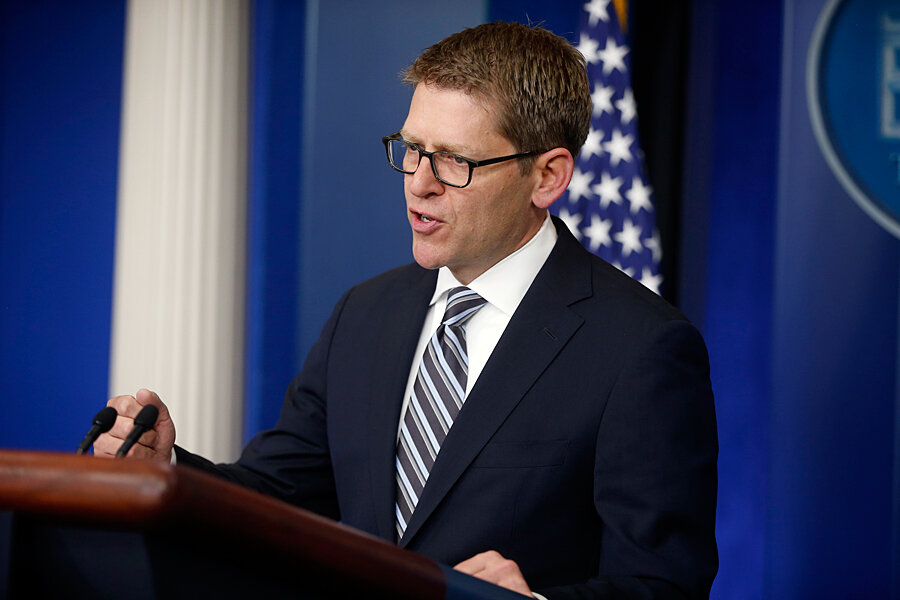Are people paying their Obamacare premiums? Yes and no.
Loading...
| Washington
The Obama administration acknowledges that not everyone who enrolled in health coverage via government-run exchanges has paid his or her first premium. Thus, not all 8 million enrollees, in fact, have health insurance.
But on Thursday, the White House threw cold water on an assertion made the day before by leaders of a Republican-led House committee that only two-thirds of enrollees had paid their premiums by April 15.
“Let’s begin with the fact that the committee says they looked at who paid by April 15,” White House spokesman Jay Carney said, “but as you know ... there was a tremendous surge in enrollments at the end of the process.”
That included people who were in line at midnight on March 31 and were able to complete their enrollments by April 15, he said. “So a lot of those folks haven't even gotten notices yet or bills yet to pay their premiums.”
Mr. Carney also referenced recent public comments by insurance company executives, “most of [whom] have indicated that they're seeing 80 to 90 percent of their enrollees pay their premiums.”
In a report released Thursday on health insurance enrollment via the exchanges through April 19, the Department of Health and Human Services (HHS) said it did not have comprehensive data on paid enrollment. But the report repeated the 80 to 90 percent figure, sourcing it to public statements by insurers. An HHS spokeswoman said she didn’t anticipate having that information until later this year.
In early April, the Blue Cross and Blue Shield Association estimated that 80 to 85 percent of people who had selected one of its plans through the marketplace had made their first payment, based on policies that took effect on Feb. 1 or earlier. On Wednesday, the insurer WellPoint said about 90 percent of its sign-ups had paid.
Republican leaders of the House Committee on Energy and Commerce, which released the report Wednesday saying only 67 percent of enrollees had paid, said they got their data from 160 health insurers selling policies on the federal exchange. At the White House briefing Thursday, Carney said there are more than 300 insurance companies.
“So what you have here is partial information packaged in a way to try to undermine what must be a depressing reality to those who want to repeal the Affordable Care Act, which is that millions of Americans enrolled, exceeding even our most optimistic projections,” Carney said.
In its report Thursday, HHS for the first time released demographic data about enrollees:
• 54 percent are female and 46 percent are male.
• 34 percent are under age 35, and 28 percent are between the ages of 18 and 34.
• 65 percent selected a “silver” plan, which offers the second-lowest premiums, and 20 percent chose “bronze,” which has the lowest premiums but the highest deductibles.
• 85 percent received a federal subsidy to buy insurance.
The federal marketplace application contained optional questions about race and ethnicity, and 69 percent of applicants answered. HHS also released that data Thursday. Of those who responded, 63 percent were white, 17 percent were African-American, 11 percent were Latino, 8 percent were Asian, 1 percent were multiracial, 0.3 percent were American Indian/Alaska native, and 0.1 percent were native Hawaiian/Pacific Islander.
Latino enrollment was “slightly lower” than the qualified population, an HHS official acknowledged. Latinos make up 17 percent of the US population.
“There is more work to do,” said Mayra Alvarez, associate director for the Office of Minority Health at HHS.
The department also offered assurances that each state is on track to have a “stable risk pool” in its individual health insurance market.
“All of the projections that we’re familiar with, our own and others, suggest that the pool of individuals across the states who have picked a plan and enrolled is sufficient to produce a stable risk pool around which premiums and products will be priced,” said Michael Hash, director of the Office of Health Reform at HHS.
That was true in every state, Mr. Hash added. Health market analysts have been speculating over the price of health insurance premiums when the next open enrollment period begins on Nov. 15.
In more than 12 states – including some of the nation’s largest – enrollment at least doubled since March 1, HHS reported. In Texas, enrollment went up 149 percent; in Georgia, 127 percent; and in Florida, 123 percent.








